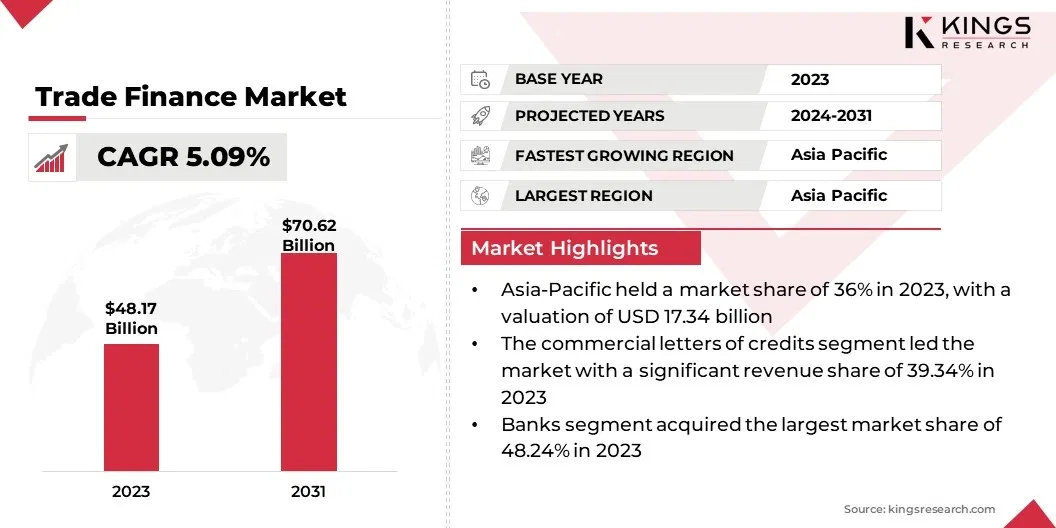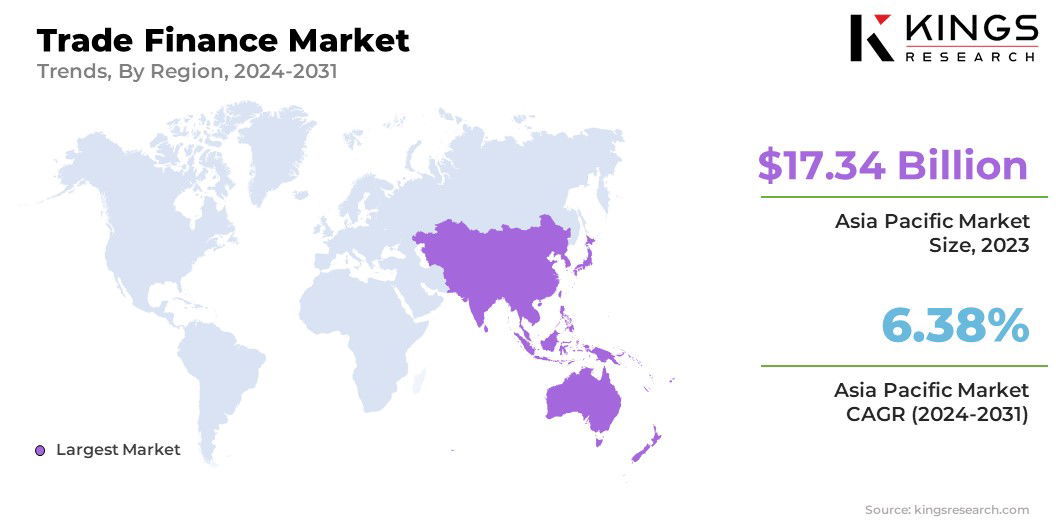BFSI

Trade Finance Market

Trade Finance Market Size, Share, Growth & Industry Analysis, By Product Type (Commercial Letters of Credits, Guarantees, Standby Letters of Credits, Others), By Provider (Banks, Trade Finance Houses, Others), By Application (Domestic, International) By End User and Regional Analysis, 2024-2031
Pages : 120
Base Year : 2023
Release : April 2024
Report ID: KR592
Trade Finance Market Size
The global Trade Finance Market size was valued at USD 48.17 billion in 2023 and is projected to reach USD 70.62 billion by 2031, growing at a CAGR of 5.09% from 2024 to 2031. In the scope of work, the report includes solutions offered by companies such as BNP Paribas, Citigroup, Inc., TD Bank, UBS, Arab Bank, DBS Bank Ltd, JPMorgan Chase & Co., Santander Bank, Deutsche Bank AG, Bank of America Corporation and Others.
The global market is experiencing notable growth, driven by various factors such as the rise in global trade operations and an increased need for financial tools that support international trade transactions. As companies analyze overseas markets, the necessity for specialized trade finance services such as letters of credit, guarantees, and export/import financing becomes increasingly imperative.
Additionally, advancements in technology and the shift toward digitalization are contributing to the transformation in the trade finance market. The incorporation of digital platforms and trade finance has significantly streamlined trade transaction processes, thereby enhancing operational efficiency and reducing the dependency on traditional paperwork.
Moreover, there is a growing trend of collaboration between conventional financial institutions and fintech companies, enabling the fusion of innovative technologies and knowledge, thus fostering the creation of innovative trade finance solutions.
Furthermore, noteworthy partnerships between banks and fintech entities have facilitated the emergence of digital trade finance platforms that deliver comprehensive solutions, thereby enhancing accessibility and efficiency for businesses which is significantly accelerating the market expansion in the coming years.
 Click to learn, How data-driven insights can impact your market position
Click to learn, How data-driven insights can impact your market position
Analyst’s Review
The trade finance market has witnessed substantial growth in recent years, propelled by the increasing globalization of trade, which has created a greater demand for efficient and secure financing solutions. As businesses expand their operations across borders, the need for reliable and optimized financing options has become critical. Furthermore, the rise of e-commerce and digital technologies has significantly influenced the trade finance landscape.
Furthermore, the growing complexity of international trade regulations is driving the expansion of the trade finance market. With regulations becoming more intricate and diverse, businesses require specialized financial services to effectively navigate the challenges they present.
This has resulted in a rise in the demand for tailored solutions that can assist in managing risks and ensuring smooth transactions in compliance with these regulations. This growth trajectory emphasizes the importance of innovation and security in meeting the evolving needs of businesses engaged in international trade.
Market Definition
Trade finance is a specialized field within finance that focuses on providing funding and financial instruments to support international trade transactions. Its primary objective is to mitigate the risks involved in cross-border trade and play a crucial role in facilitating global commerce.
One of the key functions of trade finance is to assist businesses in managing cash flow fluctuations that can arise from varying payment terms and delivery schedules. Through mechanisms such as letters of credit, trade finance institutions enable businesses to secure timely payment for their goods and services, thereby reducing the risk of non-payment or delayed payment.
Moreover, trade finance institutions often provide valuable expertise and resources to help businesses navigate the intricacies of international trade. This includes guidance on compliance with regulations, risk assessment, and documentation requirements.
Furthermore, the trade finance market is subject to substantial influence from the evolving regulatory landscape. This is primarily driven by regulatory initiatives that aim to improve transparency, risk management, and compliance within the industry. As a result, there is a growing demand for trade finance solutions that align with these regulatory requirements.
- For instance, initiatives such as Know Your Customer (KYC) and Anti-Money Laundering (AML) regulations have played a significant role in influencing this shift in the market. Compliance with KYC and AML regulations has become a crucial aspect of trade finance operations, as it fosters trust among participants and strengthens the integrity of the global trade ecosystem.
Trade Finance Market Dynamics
The expansion of international trade is stimulating the development of the trade finance market as businesses increasingly seek financing solutions to support their international transactions.
The expansion of global supply chains and the emergence of e-commerce platforms have significantly increased the demand for trade finance products. This demand is further propelled by the rising complexity of cross-border trade regulations, necessitating financial institutions to provide efficient and secure financing options to support their clients' trade activities.
Moreover, the increasing presence of small and medium-sized enterprises (SMEs) in the global market has created a need for innovative trade finance solutions tailored to their specific requirements.
Financial institutions are continuously developing new trade finance products and services to meet the evolving demands of businesses engaged in international trade. These solutions often leverage technology, such as blockchain and digital platforms, to streamline the processes, reduce costs, and mitigate risks associated with cross-border transactions.
By offering customized trade finance solutions, financial institutions aim to assist SMEs in accessing the necessary funding to expand their businesses globally and navigate the complexities of international trade. Trade finance plays a crucial role in facilitating global commerce and fostering economic growth.
However, high transaction costs and fees within the trade finance sector have emerged as a significant barrier to the growth of the market. These costs substantially diminish the profitability of businesses engaged in international trade, making it less appealing to participate in such activities.
Particularly, small and medium-sized enterprises (SMEs) face challenges in affording the substantial fees associated with trade finance, thereby constraining their capacity to expand their operations globally.
Segmentation Analysis
The global market is segmented based on product type, provider, application, end user, and geography.
By Product Type
Based on product type, the market is bifurcated into commercial letters of credits, guarantees, standby letters of credit, and others. The commercial letters of credits segment led the trade finance market with a significant revenue share of 39.34% in 2023. This growth is mainly attributed to its secure and reliable nature.
By providing a guarantee of payment from the issuing bank to the beneficiary, letters of credit reduce the risk for both parties involved in the transaction. This level of assurance has made it the preferred choice for international trade transactions, where trust and security are paramount.
Additionally, the standardized process of letters of credit streamlines the payment process, making it more efficient and cost-effective for businesses. These factors have contributed to the widespread adoption of commercial letters of credit in the market.
By Provider
Based on provider, the market is bifurcated into banks, trade finance houses, and others. Banks acquired the largest market share of 48.24% in 2023, primarily due to its established network of branches and relationships with businesses worldwide.
Banks have the resources and expertise to provide a wide range of trade finance services, such as letters of credit, documentary collections, and trade loans. Additionally, banks offer secure and reliable payment solutions, giving businesses confidence in their transactions. This level of trust and efficiency has made banks the preferred choice for many companies engaging in international trade.
Furthermore, banks often have dedicated trade finance departments staffed with professionals who understand the complexities of global trade and can provide valuable guidance to businesses. This level of personalized service sets banks apart from other financial institutions and further solidifies their position as leaders in the trade finance market.
By Application
Based on application, the market is bifurcated into domestic, and international. The international segment dominated the trade finance market with a notable share of 58.19% in 2023, fueled by globalization and the increasing interconnectedness of economies worldwide.
Companies are expanding their operations globally, leading to a higher demand for trade finance services to facilitate cross-border transactions. Additionally, advancements in technology have made it easier for businesses to engage in international trade, thereby driving the growth of the international segment in the market.
Trade Finance Market Regional Analysis
Based on region, the global market is classified into North America, Europe, Asia Pacific, MEA, and Latin America.

The Asia-Pacific Trade Finance Market share stood around 36% in 2023 in the global market, with a valuation of USD 17.34 billion, majorly attributed to its robust infrastructure and technological advancements. Additionally, countries such as China and Singapore have invested heavily in developing state-of-the-art trade finance platforms, making transactions faster, more efficient, and more secure.
Furthermore, the region's strategic geographical location serves as a gateway between East and West, facilitating seamless trade flows and attracting businesses from around the world. Moreover, the growing middle-class population in countries such as India and Indonesia has led to increased demand for imported goods, thereby raising the need for trade finance services in the region. These factors have contributed to Asia-Pacific's strong position in the trade finance market.
Furthermore, the increasing integration of trade finance into the global economy is resulting in a rise in cross-border trade activities. Additionally, advancements in technology have made trade finance more accessible and efficient for businesses in this region. This has attracted a larger number of companies to engage in international trade, thereby further driving the growth of the market in the region.
Moreover, the presence of key players in the countries, such as China and Japan, has contributed to the development of robust trade finance infrastructure, making it easier for businesses to access financing options. These factors have solidified Asia-Pacific's leading position in the global market.
Competitive Landscape
The trade finance market report will provide valuable insight with an emphasis on the fragmented nature of the industry. Prominent players are focusing on several key business strategies such as partnerships, mergers and acquisitions, product innovations, and joint ventures to expand their product portfolio and increase their market shares across different regions.
Strategic initiatives, including investments in R&D activities, the establishment of new manufacturing facilities, and supply chain optimization, could create new opportunities for market growth.
List of Key Companies in Trade Finance Market
- BNP Paribas
- Citigroup, Inc.
- TD Bank
- UBS
- Arab Bank
- DBS Bank Ltd
- JPMorgan Chase & Co.
- Santander Bank
- Deutsche Bank AG
- Bank of America Corporation
Key Industry Developments
- December 2023(Launch): The global banking institution, Standard Chartered Bank, unveiled a new trade financing product aimed at sustainable development. This innovative offering is designed to assist financial entities in offering liquidity that supports sustainable growth in the regions that require it the most.
The global Trade Finance Market is segmented as:
By Product Type
- Commercial Letters of Credits
- Guarantees
- Standby Letters of Credits
- Others
By Provider
- Banks
- Trade Finance Houses
- Others
By Application
- Domestic
- International
By End User
- Traders
- Importers
- Exporters
By Region
- North America
- U.S.
- Canada
- Mexico
- Europe
- France
- UK
- Spain
- Germany
- Italy
- Russia
- Rest of Europe
- Asia Pacific
- China
- Japan
- India
- South Korea
- Rest of Asia Pacific
- Middle East & Africa
- GCC
- North Africa
- South Africa
- Rest of Middle East & Africa
- Latin America
- Brazil
- Argentina
- Rest of Latin America
CHOOSE LICENCE TYPE
CUSTOMIZATION OFFERED
Additional Company Profiles
Additional Countries
Cross Segment Analysis
Regional Market Dynamics
Country-Level Trend Analysis
Competitive Landscape Customization
Extended Forecast Years
Historical Data Up to 5 Years
.webp)